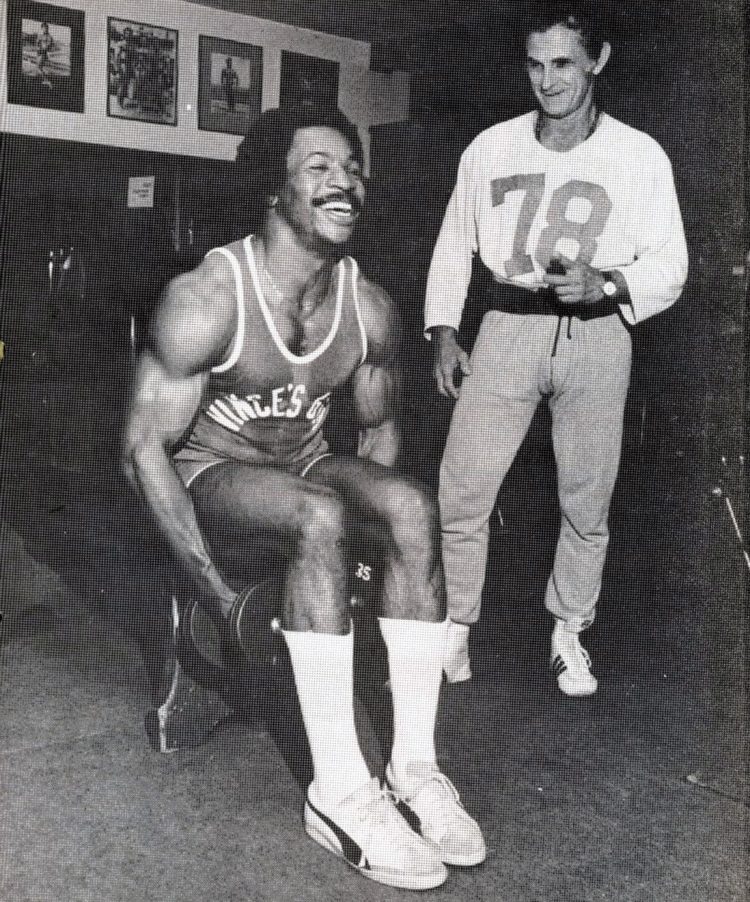When it comes to choosing set/rep schemes for bodybuilding, most fitness experts suggest doing several sets of somewhere between 8-12 reps. This allows you to use moderately heavy weights and create a time under tension (TUT) of around 30-60 seconds, which is considered optimal for hypertrophy.
As such, a lot of bodybuilders automatically gravitate toward doing sets of 8, 10, or 12 reps per set for every exercise in their workouts.
That’s why you’ll see workout prescriptions like this so often:
- 2 sets of 12 reps @ 60% 1RM
- 3 sets of 10 reps @ 70% 1RM
- 4 sets of 8 reps @ 80% 1RM
However, several studies have disproved the importance of time under tension, and that calls the 8-12 rep range into question. It seems that you can build muscle with sets lasting 60-90 seconds and sets as short as 15-20 seconds (1). TUT is not all as important as we once thought.
Read more about the TUT myth here.
What matters more is overload, i.e., challenging your muscles with increasingly intense workouts. It doesn’t matter if you fail after five reps or 15 reps. So long as your muscles are challenged sufficiently, they’ll respond by getting bigger.
Level Up Your Fitness: Join our 💪 strong community in Fitness Volt Newsletter. Get daily inspiration, expert-backed workouts, nutrition tips, the latest in strength sports, and the support you need to reach your goals. Subscribe for free!
So, while there is nothing wrong with doing 8-12 reps for your bodybuilding workouts, you don’t have to stick with that rep range forever. In fact, doing nothing but 8-12 reps per set could actually hurt your progress.
That’s because your body quickly adapts to doing the same thing over and over. So even if you increase your training weights or change the exercises (2) in your workouts, only doing 8-12 reps could mean your progress is not as good as it could be.
If you’ve been doing sets of 8-12 reps per set for a while, it’s probably time to try something new. This could be the variation you need to get your progress back on track.
Here are 11 of the best set/rep schemes for hypertrophy.
11 Best Set/Rep Schemes for Hypertrophy
Remember, 8-12 reps per set can work, but if that’s all you ever do, your progress could be affected. Use these less common set and rep schemes to stay out of training ruts and make your workouts more productive.
Note – most of these set/rep schemes specify a specific percentage of your one-repetition maximum, or %1RM for short, e.g., 75% 1RM. Use this online 1RM calculator to determine the correct weights for your workouts.
Please also remember that the prescribed 1RMs are just your starting point for these set/rep schemes. To continue making progress, you should do your best to increase your weights every week or whenever you can while maintaining good exercise form.
1. 5 sets of 5 reps with 75-85% 1RM
Five sets of Five reps is a classic set/scheme. Popularized by golden-era bodybuilders like Reg Park and Bill Pearl, as well as legendary football strength coach Bill Starr, this training method builds size and strength in equal measure. In fact, it’s basically a form of powerbuilding.
There are several ways to use this training method:
- 5 sets of 5 reps with the same weight
- 4 progressively heavier sets of 5 reps leading up to a final set of 5 with a maximal weight e.g., 120, 130, 140, 150, and 160 lbs.
- Doing all five sets with the same weight but alternating heavier days (80-85% 1RM) and lighter days with (75% 1RM)
- Starting heavy but then reducing the weight by 5-10% per set, e.g., 200, 180, 165, 150, 140 lbs.
2. 1/6 contrast loading
Like five sets of five reps, this set and rep scheme builds muscle size and strength in equal measure. With this method, you alternate between heavy singles and sets of six reps. The heavy single helps to fire up your nervous system so you can use a heavier weight or crank out more reps on the next set of six reps.
Do a total of six sets, three singles and three sets of six, i.e.,
- 90% 1RM x 1
- 70% 1RM x 6
- 92.5% 1RMx 1
- 75% 1RM x 6
- 95% 1RM x 1
- 80% x 1RM 6+
Rest 2-3 minutes between each set.
3. 10/8/6/15-20 using 50-75% 1RM
This simple set/rep scheme is very effective for hypertrophy and superior to doing several sets with the same number of reps or the same weight. The final set is a high-rep pump set that drives lots of oxygenated blood into your muscles, which could help facilitate extra growth.
For example:
- 60% x 10 (rest 60 seconds)
- 70% x 8 (rest 90 seconds)
- 80% x 6 (rest 12 seconds)
- 50% x 15-20 reps
4. 6 x 6 with 60-70% 1RM
This deceptively demanding set/rep scheme was one of Vince “The Iron Guru” Gironda’s favorite training methods. In fact, he called it the Mr. Olympia method after using it with Larry Scott, who won the first-ever Mr. Olympia way back in 1965.
The aim of this set/rep scheme is not to overload the muscles with heavy weights but to try and do as much work as possible in the shortest amount of time. As such, rest periods were limited to just 30 seconds between exercises and reduced week by week, i.e.:
- 1st week – 6 sets of 6 reps, 60% 1RM, 30 seconds rest between sets
- 2nd week – 6 sets of 6 reps, 60% 1RM, 25 seconds rest between sets
- 3rd week – 6 sets of 6 reps, 60% 1RM, 20 seconds rest between sets
- 4th week – 6 sets of 6 reps, 60% 1RM, 15 seconds rest between sets
- 5th week – 6 sets of 6 reps, 62.5% 1RM, 30 seconds rest between sets, etc.
Be warned, this set/rep scheme is intense, so resist the temptation to go too heavy too soon.
5. 5/4/3/2/1 ladder sets with 70% of your 1RM
This workout method allows you to do 15 reps with a weight you would typically be able to lift just ten times. This increase in training volume could be just what you need to get your muscle growth back on track.
However, this is a very intense set/rep scheme, so only use it for 3-4 weeks before switching to a lower intensity training method.
Level Up Your Fitness: Join our 💪 strong community in Fitness Volt Newsletter. Get daily inspiration, expert-backed workouts, nutrition tips, the latest in strength sports, and the support you need to reach your goals. Subscribe for free!
- Do 5 reps with 70% 1RM
- Rest 10-15 seconds
- Do 4 reps with 70% 1RM
- Rest 10-15 seconds
- Do 3 reps with 70% 1RM
- Rest 10-15 seconds
- Do 2 reps with 70% 1RM
- Rest 10-15 seconds
- Do 1 rep with 70% 1RM
- Rest 2-3 minutes and repeat twice more to total three sets
6. Myo-reps with 60% 1RM
Myo-reps is a form of rest-pause training. That means you rep out to failure, rest (pause) a few seconds, and then pump out some more reps. With myo-reps, you basically roll six sets into one extended rest-pause set. This keeps your muscles very close to failure for an extended period, delivering an excellent hypertrophic workout in double-quick time.
Because myo-reps are so intense, one run-through per exercise should be all you need (and want!) to do.
To use the myo-reps method:
- Activation set – Use about 60% of your 1RM and rep out until you reach failure. Make a mental note of how many reps you did.
- 3-5 mini-sets – rest 10-15 seconds, and then do 25% of the reps of your original set. So, if you did 12 reps, pump out another three.
- Repeat – rest another 10-15 seconds, and then do a second “mini set.” Continue until you cannot do three reps or complete a total of five mini sets.
Related: Myo-Reps Workout for Muscle Size and Strength
7. 6+4 reps with 75-80% 1RM
6+4 is another form of rest-pause training. This method allows you to do ten reps with a weight you can typically only lift six times. This will increase strength and muscle mass. 6+4 is a very intense rep scheme, so only do three sets per exercise and replace it with a lower intensity set/rep scheme after four weeks.
- Select 75-80% of your 1RM and pump out six reps
- Rest for 15-20 seconds
- Crank out another couple of reps
- Rest another 15-20 seconds
- Pump out the remaining rep(s)
- Rest for 2-3 minutes and repeat
8. 8 sets of 3 with 80-85% 1RM
This set rep scheme takes the standard approach of three sets of eight, flips it on its head, and increases the weight. The result is a workout that will build size and strength. Take just 60 seconds between sets to increase the metabolic demands of this high-tension training method.
The 8 sets of 3 set/rep scheme works best with compound exercises, e.g., squats, bench presses, deadlifts, and overhead presses. However, you could also use it for curls, leg extensions, etc., providing you can do those exercises safely with heavy weights.
How to do it:
- Perform eight sets of three heavy reps, resting just 60 seconds between sets.
- Don’t train to failure. Instead, you should be able to perform four reps per set but stop at three.
- Use good form but don’t worry about tempo. Lower the weight under control but then lift it as fast as possible while maintaining good form. Lifting explosively will increase muscle fiber recruitment.
9. 50% sets
50% sets are an excellent alternative to straight sets, e.g., three sets of ten. Each set is taken to failure, which means it’s a very intense form of training. However, it’s also self-regulating. The number of sets you do will depend on how strong and energetic you feel.
Simply do your first set to failure, rest exactly 60 seconds, and then do another set with the same weight. Because of fatigue, you won’t be able to do as many reps before being forced to stop. Rest for 60 seconds again and do another set. Keep going until you cannot complete 50% of the number of reps in your first set.
Example:
- 1st set – 12 reps
- Rest 60 seconds
- 2nd set – 10 reps
- Rest 60 seconds
- 3rd set – 8 reps
- Rest 60 seconds
- 4th set – 7 reps
- Rest 60 seconds
- 5th set – 5 reps (less than 50% of 12 reps, so you are all done!)
If you weren’t feeling great, you might find that you hit 50% of your opening set quite quickly. But, if you are feeling strong, it could take you five or more sets. Just go with the flow and allow your fatigue levels to dictate the number of sets you do.
10. 40 reps with 80% 1RM
With this scheme, there are no sets to worry about. Instead, your goal is to accumulate 40 reps with 80% of your 1RM in as little time as possible. You’ll be using roughly your 8RM. Simply do as many reps as you can, rest 45-60 seconds, and then go again. Continue until you complete 40 total reps, regardless of how many sets it takes.
Take each set to failure, and don’t worry if you cannot do eight reps for more than the first couple of sets.
For example:
- 8 reps, rest 45 seconds
- 8 reps, rest 45 seconds
- 7 reps, rest 45 seconds
- 6 reps, rest 45 seconds
- 4 reps, rest 45 seconds
- 4 reps, rest 35 seconds
- 3 reps, rest 45 seconds
- Total = 40 reps
11. 100 reps with 60% 1RM
This final rep scheme is the same as #10 but, instead of using your 8RM, which is pretty heavy, you’ll be using closer to your 12-15RM. As before, keep your rests short – about 30 seconds – and try and pump out the reps in as few sets as possible.
Because the weight is light and the reps are high, this is a great way to trigger a deep burn and pump and is ideal for those days you don’t feel like lifting heavy weights. It’s also a good option for bodyweight and light resistance band exercises.
How Often Should You Change Set/Rep Schemes?
As the old saying goes, if it ain’t broke, don’t fix it. If your current set/rep scheme is producing the results you want, you should probably stick with it. So, if you’re still able to increase your weights or your muscles are getting noticeably bigger, there is no need to make any changes.
But, if you are unable to increase your weights or otherwise feel that your progress has stalled, shake up your workouts with a new set/rep scheme.
With 11 different set rep schemes to choose from, plus the old standard of 3-4 sets of 8-12 reps, you’ve got more than enough options to last a year or more. Combined with a few exercise changes, that’s more than enough variety to keep you out of any training ruts that could ambush your progress.
Set/Rep Schemes for Hypertrophy – Wrapping Up
I once met a bodybuilder who did nothing but sets of 16. It didn’t matter if he was doing deadlifts or lateral raises; he always did four sets of 16 reps. This worked for him, but such a limited approach won’t work for everyone. It probably helped that he was juiced up to the eyeballs!
If you’ve been using the same set and rep scheme for a while and you’re still making progress, you might as well stick with it. But, if you’re going nowhere fast, it’s probably time for a change.
Use these new hypertrophy set and rep schemes to bust out of your training rut and get back on the gains train!
References
1. PubMed: Resistance Exercise Load Does Not Determine Training-Mediated Hypertrophic Gains in Young Men https://pubmed.ncbi.nlm.nih.gov/22518835/
2. PubMed: The Effects of Exercise Variation in Muscle Thickness, Maximal Strength and Motivation In Resistance Trained Men https://pubmed.ncbi.nlm.nih.gov/31881066/












hello, in the scheme number 9.50% sets, what method of progression. is used to raise the weight in the exercise?, and what number of repetitions is performed in the first series?
thank you,
a great item.
Hi Daniel – thanks for your question.
You can adapt this method to your goals and preferences.
For example, you could start with an all out set of 12 reps with a moderate weight like the example, or do a set of 20 with a light weight. Or, you could use a heavier weight and do just six reps. So long as you take all sets to failure then you’re good.
Then just keep doing a set each minute to failure until you reach 50% of your original number of reps. If you’ve got lots of energy, this could be 5-6 sets. If you’re feeling tired, it could be 3-4 sets. It’s a form of self-regulation, so we can’t say exactly how many reps you’l perform or how many sets it’ll take, and there is no perfect number.
As for progression, just add a little weight week by week, or try to hit 50% in 1-2 fewer sets and then increase the load.
Hope that helps!
Hello, excellent article.
How many exercises per muscle group can be done with exercise plan number 9 from the article 50% Sets?
Is one exercise per muscle group enough?
Thank you very much in advance for your attention. Kind regards.
Hi again Daniel and thanks for your question.
Re. 50% sets, you can apply this method to just one or a couple of exercises per muscle group. One exercise will be effective if you train that muscle several times a week, e.g., you do full-body workouts. But, if you only train your muscles once a week, as with a split routine, more exercises will work better. Hope that helps!
Patrick.
Thank you very much for the clarification. I’m going to use the 50% regime for a couple of months.
I’d like your opinion on applying it 10×10 with a single exercise per body part and using the self-regulation of the 50% training system.
I’d start with a base of 10 reps, and when I complete a set of 5 reps, I’d stop the exercise for that body part.
And I’d limit myself to 10 sets if I feel strong.
Thank you again.
Hi Daniel – that sounds like an interesting approach – a bit of a variation of German Volume Training. Give it a try and see what happens – you may have invented a whole new type of training! Feel free to let me know how you get on.